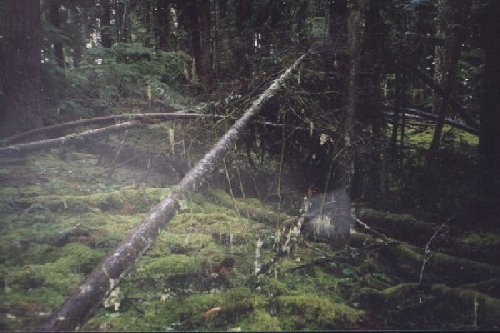January 18, 1999
More Indian Henry
Met with a well-known Sasquatch researcher at the Eagle Creek Chevron. He wishes to remain anonymous in these reports. I had called him to get an opinion on the baiting sites and how I had done them. He was happy to come along. (Update: unnamed companion was Todd Neiss of Mt. Hood, Oregon)
It was high overcast, no rain or snow falling and quite chilly.
I had named the baiting sites, Joe Sites 1 and 2 because I had selected them and set them up. Cliff and I hoped to do a series of baiting sites at different places this winter and spring before the summer people started bouncing around the woods.
Don't think my companion was too impressed with the lures and baits.View of shelter found by Todd Neiss Indian Henry Road 1/99 Companion found the crosshatched trees when he was scouting the area. He has credit for them because he saw them as a structure! I hadn't given them any more thought. He had no explanation for it. He showed me that there had been some branches put over the center and that it clearly looked like something had used the area beneath as all the little branches were smashed flat.
"Shelter" up Indian Henry discovered by Todd Neiss. Note triangulated trees.
Under the teepee, he and I could easily stand erect. The structure was right on a game trail. He also determined that the way the trees had fallen was totally inconsistent with the way other trees had come down under the tall old growth canopy.
Large, deep imprint found by Todd Neiss up Indian Henry about 50 yards from shelter
He also found quite a deep imprint along side a tree near the structure. We think it was probably made a few months earlier in the fall. It was large and clearly foot like. It was a couple of inches deep on the up side of the print. I couldn't even bust the ground around it, let alone make the impression.
I found one good set of unusual impressions that had been made since I set up the baits last week. They were about 30' from the hanging Spam and were about 17"-18" long. There were some partials above it. The stride was quite long, about 50" plus. My companion took several pictures with his camera.
We thoroughly examined the impressions. They were not castable, didn't have any plaster anyway, didn't really think I would need any. This is for fun, isn't it? They were distinct in the moss that covered the forest floor. There was about a 15' rise going up to the next little flat and the prints clearly came from above and down past the lure area and then went on. Whenever the ground angled down, or a fallen log or brush was crossed, "toe" prints showed.
We determined that they were not made by deer or elk double strikes. We rolled back the moss to get a good luck at the "toe" imprints. We discussed them as being a double strike by a bear, but the distance between the imprints were too long, unless maybe the thing was running like hell. Possibly, they were made by a bounding cougar, but there was no real push-up of the heavy, thick moss as a strike bounding animal would make. Found a good second partial near the hanging fishing lure/clacking device. Again not castable. Then it looked like the critter went down into the reprod beyond the big timber.
Companion kicked up a doe down by the seasonal water hole. It went below me, not too excited on its way to the brush.
We really had a good talk about Bigfooting. We didn't do any long walks. Spent all our time around the two bait stations. My companion of the day really knows his stuff about Sasquatch.All website content is © Copyright 2000, Joseph Hector Beelart, Jr. unless otherwise noted.
All rights reserved.



